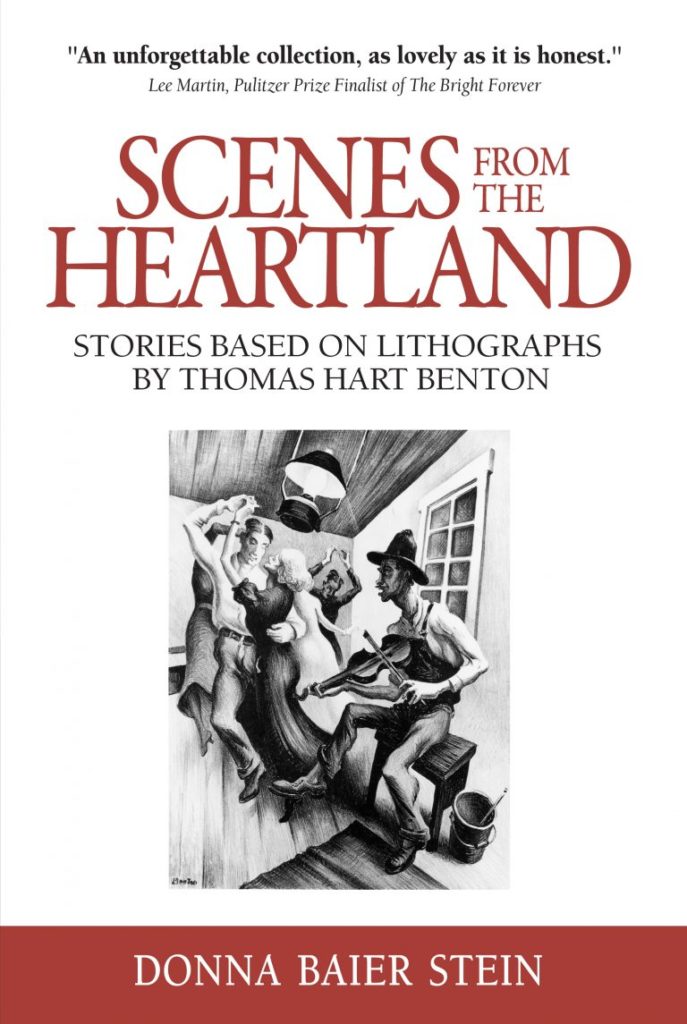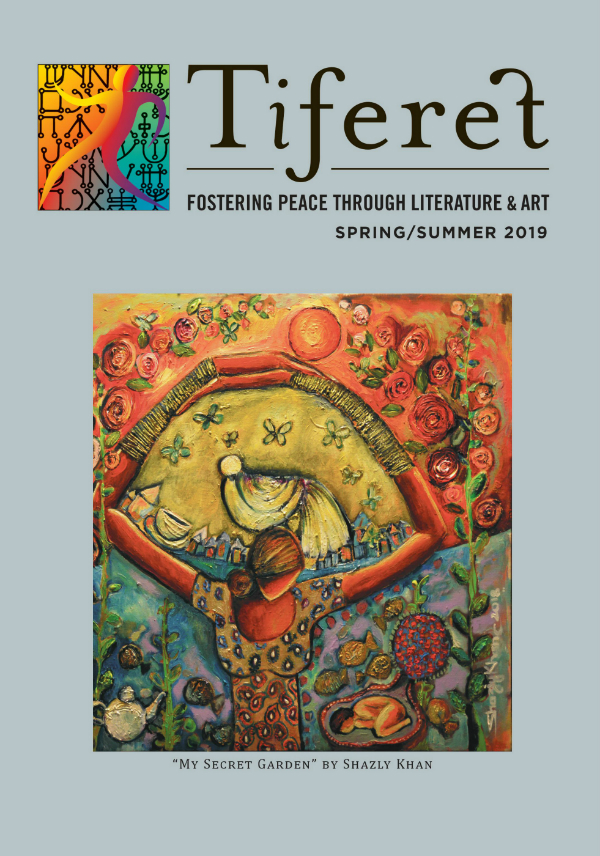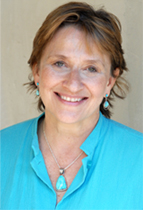
This blog posts on Mondays. Fourth Mondays of the month I devote to a Q & A with a fellow writer.
It has been more than a couple of years now since I participated as faculty at the San Miguel Writers Conference, but shining bright in my memory is a chat in the emerald cool shade of some palm trees there with Donna Baier Stein. And then we crossed paths again at the Women Writing the West Conference. Pequeño mundo! And at some point in between, to my great honor, she published an excerpt from my book, Metaphysical Odyssey into the Mexican Revolution, in her journal, Tiferet. Donna Baier Stein’s latest book is a collection of short stories inspired by artworks by Thomas Hart Benton– one of the greatest of the greats among American artists, and a personal favorite of mine.

Here’s the catalog copy:
“When a contemporary writer turns her imagination loose inside the images of an iconic artist of the past, the result is storytelling magic at its best. Here are nine tales that bring to vivid life the early decades of the 20th century as witnessed by one of America’s most well-known painters. Thomas Hart Benton sketched fiddlers and farm wives, preachers and soldiers, folks gathering in dance halls and tent meetings. Though his lithographs depict the past, the real-life people he portrayed face issues that are front and center today: corruption, women’s rights, racial inequality.
“In these stories we enter the imagined lives of Midwesterners in the late 1930s and early 1940s. A mysterious woman dancing to fiddle music makes one small gesture of kindness that helps heal the rift of racial tensions in her small town. A man leaves his childhood home after a tragic accident and becomes involved with the big-time gamblers who have made Hot Springs, Arkansas, their summer playground. After watching her mother being sent to an insane asylum simply for grieving over a miscarriage, a girl determines to never let any man have any say over her body.
“Then as now, Americans have struggled with poverty, illness, and betrayal. These fictions reveal our fellow countrymen and women living with grace and strong leanings toward virtue, despite the troubles that face them.”
C.M. MAYO: When and where did you first encounter Thomas Hart Benton’s work, and what inspired you do write this whole collection of stories?
DONNA BAIER STEIN: My father, a nearly lifelong Kansas Citian, was given an early edition lithograph by Benton in the 1950s. This was passed on to me, and I had it hanging on my office wall for many years. One day, moved by a desire that my next writing project be based on something something outside of my own life experiences, I started writing down what I saw in the picture, which showed a horse galloping across a field and two boys riding bareback, one of whom has just fallen off the animal. This led to the creation of fictional characters and a plot. After that first story was published in Virginia Quarterly Review, I wrote eight more. I owned a book of Benton’s black and white lithographs compiled and edited by Creekmore Fath and picked out images from that book that resonated with me.
C.M. MAYO: If a reader were to read one story in this collection, which one would you suggest, and why?
DONNA BAIER STEIN: Probably “Morning Train.” It’s one of my favorites because I am most intrigued by its main character, Ruth, and how she deals with the masculine.
C.M. MAYO: Can you talk about which writers have been the most important influences for you?
DONNA BAIER STEIN: Writers I grew up admiring were John Updike, Kurt Vonnegut, Saul Bellow, Ray Bradbury. Unfortunately when I was in high school we weren’t reading a lot of women writers! I also loved Faulkner, Melville, Woolf.
C.M. MAYO: Which writers are you reading now?
DONNA BAIER STEIN: I just finished Great American Desert by Terese Svoboda, which is absolutely stunning. I look forward to reading more of her books. After finishing Plainsong by Kent Haruf I immediately dove into its follow-up, Eventide.
C.M. MAYO: Before earning your MFA in writing, you had had a career as a copywriter. How do you think doing this kind of writing affected your literary writing?
DONNA BAIER STEIN: Well, it had good and bad effects! Good in the sense that it taught me to write even when I didn’t feel like it, made me comfortable with writing imperfect first drafts, and helped build the muscle memory of writing. It was bad in that I spent many years avoiding my own creative writing, or doing it only in bits and pieces on the side.
C.M. MAYO: You are founding editor and publisher of Tiferet Journal. Can you talk about what inspired you to do that? And how do you see Tiferet now and in the future?
DONNA BAIER STEIN: I had been fortunate enough to be asked to help found the Bellevue Literary Review. Their niche was “at the nexus of medicine and literature.” I started thinking that in addition to the body and literature, we should look at what happens at the nexus of spirit and literature. At the time I was studying something called integrated kabbalistic healing and was very interested in the spiritual matters and the ways the Word appears in all religions. My teacher in that school called language the first particularization of nothingness, and that definition appealed to me. I also learned the meaning of the word tiferet (heart, compassion, reconciliation of opposites) and fell in love with it. I am the only child of a Christian mother and Jewish father, and I grew up thinking we all need to get along. I founded Tiferet as a way to help foster interfaith dialogue. It’s a labor of love, really, and I often think about closing it down. But we have a terrific group of volunteer editors and an enthusiastic and supportive community of writers and readers. And considering how divisive our country is these days, it doesn’t seem to be the time to close up shop.

C.M. MAYO: As both an author and an editor, what is the best, most important piece of advice you would give to a writer who is just starting out to look to publish in magazines and perhaps publish a first book?
DONNA BAIER STEIN: My advice is to polish and persist. Don’t be sloppy. If your manuscript has egregious errors on the first page, it may well be ignored. If you receive rejections, consider revising and resubmit to other publications. Editors are inundated these days so your work may be rejected for reasons beyond your control.
C.M. MAYO: You have been a productive writer for many years. How has the Digital Revolution affected your writing? Specifically, has it become more challenging to stay focused with the siren calls of email, texting, blogs, online newspapers and magazines, social media, and such? If so, do you have some tips and tricks you might be able to share?
DONNA BAIER STEIN: I spend way too much time on social media, especially now as I promote Scenes from the Heartland. And I sometimes consider email the bane of my existence. That said, both social media and email are essential vehicles of communication these days. In my imagination, I envy those writers I mentioned earlier (Updike, Vonnegut, et al.) who could concentrate on writing, not on self-promotion. The self-promotion side of our brain is very different from the writer’s side, and I definitely prefer the latter. One trick that helps me is removing Facebook, Instagram, and Twitter from my cell phone and only visiting those sites when I’m at my desk on my computer. It’s very, very addictive, uncomfortably so. The plus side of the internet though is the wealth of material it puts at our fingertips. I absolutely love doing historical research for my stories and novels online.
C.M. MAYO: Another question apropos of the Digital Revolution. At what point, if any, were you working on paper? Was working on paper necessary for you, or problematic?
DONNA BAIER STEIN: I remember my former husband gave me an IBM self-correcting Selectric typewriter in, I believe, 1982. And I remember buying a lifetime supply of WhiteOut at my first trip to Price Club many years ago! I worked on a typewriter in my first job as a copywriter at Times Mirror Magazines and for many years as a freelance copywriter. I think I got my first computer, a Televideo, in the mid 1980s. Amber letters on a black screen. I LOVE the ability to correct without retyping an entire page and am pretty addicted to my laptop. I have terrible handwriting and as much as I’d like to write first drafts by hand, it’s not efficient for me. Thoughts seem to come too fast to write well with pen on paper. That said, I write drafts on the computer then print out the pages, edit by hand, input those corrections on computer, and repeat.
C.M. MAYO: What’s next for you as a writer?
DONNA BAIER STEIN: I’m working on another historical novel that features Sarah Bernhardt, Nikola Tesla, and Swami Vivekananda and takes place in Paris and New York in the 1890s. I’m fascinated by the fact that these three knew each other and were friends.
> Visit Donna Baier Stein’s website
> More about her book, Scenes from the Heartland
> Visit Tiferet Journal

Q & A: Carolina Castillo Crimm, Author of De León: A Tejano Family History
Q & A: Mary Mackey on The Jaguars That Prowl Our Dreams
The Harrowingly Romantic Adventure of US Trade with Mexico in the Pre-Pre-Pre NAFTA Era: Notes on Susan Shelby Magoffin and Her Diary, Down the Santa Fe Trail and into Mexico
Find out more about C.M. Mayo’s books, shorter works, podcasts, and more at www.cmmayo.com.


